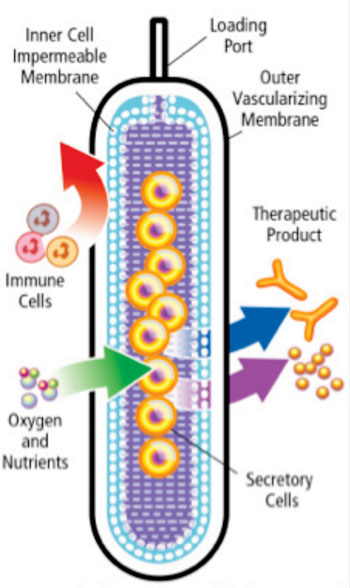Encapsulated Human-Insulin-Producing Progenitor Cells Cure Diabetes in Mouse Model
By LabMedica International staff writers
Posted on 09 Apr 2014
A breakthrough system that allows subcutaneous implantation of encapsulated immature pancreatic cells (beta progenitor cells) was shown to produce enough insulin to correct the symptoms of diabetes in a mouse model.Posted on 09 Apr 2014
Investigators at the Sanford-Burnham Medical Research Institute (La Jolla, CA, USA) and the University of California, San Diego (USA) placed CyT49 pancreatic islets derived from human embryonic stem cells (hESCs) into TheraCyte (Laguna Hills, CA, USA) encapsulation devices and transplanted the devices into a diabetic mouse model.

Image: The TheraCyte cell encapsulation device (Photo courtesy of TheraCyte, Inc.).
The TheraCyte system for encapsulating and transplanting cells is a thin membrane-bound polymeric chamber. It is fabricated from biocompatible membranes, which protect allogeneic cells from rejection by the recipient and, when implanted subcutaneously, induce the development of blood capillaries close to the membranes. This vascularization feature provides a rich blood supply to nourish the tissues within the membranes, aids in the communication of implanted cells with the host, and assures rapid uptake of therapeutic molecules. The TheraCyte system is protected by 20 US patents and multiple foreign patent filings in Europe and Japan.
The investigators monitored human insulin secretion and employed bioluminescent imaging to evaluate the maturation, growth, and containment of the encapsulated islet progenitors. They reported in the March 24, 2014, online edition of the journal Stem Cell Research that human insulin was detectable by seven weeks post-transplant and increased 17-fold over the course of eight weeks, yet during this period the biomass of encapsulated cells remained constant. Remarkably, by 20 weeks post-transplant encapsulated cells secreted sufficient levels of human insulin to ameliorate alloxan induced diabetes. Furthermore, bioluminescent imaging revealed that hESCs remained fully contained in the encapsulation device for up to 150 days, the longest period tested.
“Our study critically evaluates some of the potential pitfalls of using stem cells to treat insulin dependent-diabetes,” said senior author Dr. Pamela Itkin-Ansari, assistant professor of pediatrics at the University of California, San Diego and adjunct assistant professor at the Sanford-Burnham Medical Research Institute. “We have shown that encapsulated hESC-derived insulin-producing cells are able to produce insulin in response to elevated glucose without an increase in the mass or their escape from the capsule. These results are important because it means that the encapsulated cells are both fully functional and retrievable.”
“We were thrilled to see that the cells remained fully encapsulated for up to 150 days, the longest period tested,” said Dr. Itkin-Ansari. “Equally important is that we show that the progenitor cells develop glucose-responsiveness without a significant change in mass – meaning they do not outgrow their capsule, and, of course, we want to learn how long a capsule will function once implanted. Given these goals and continued successful results, I expect to see the technology become a treatment option for patients with insulin dependent-diabetes.”
Related Links:
Sanford-Burnham Medical Research Institute
University of California, San Diego
TheraCyte, Inc.








 (3) (1).png)




